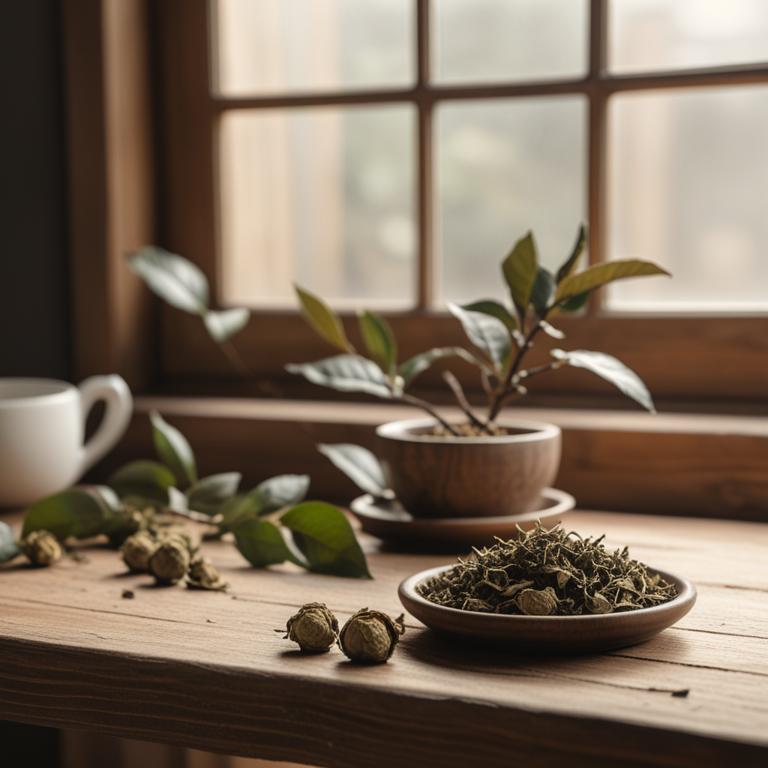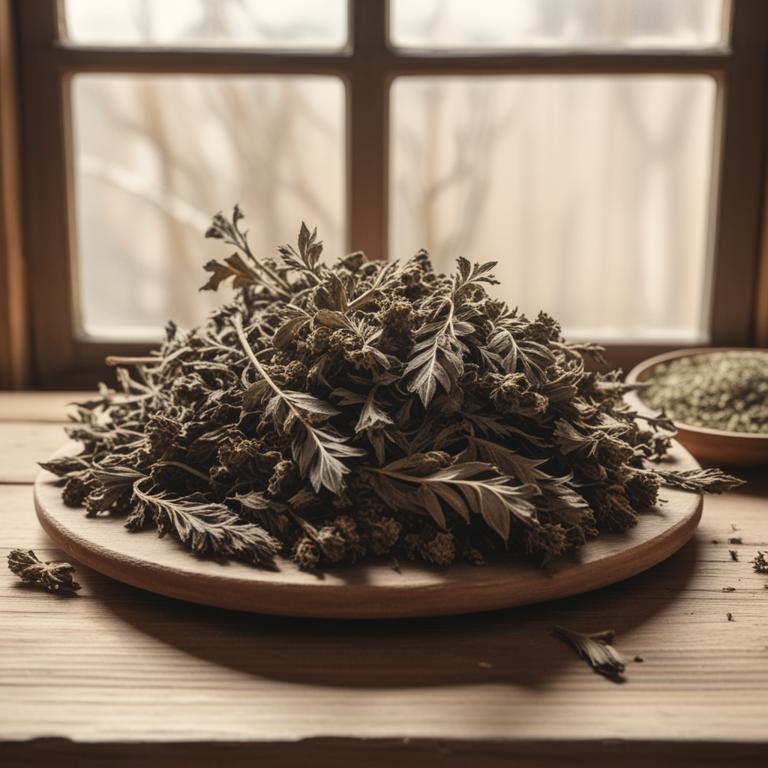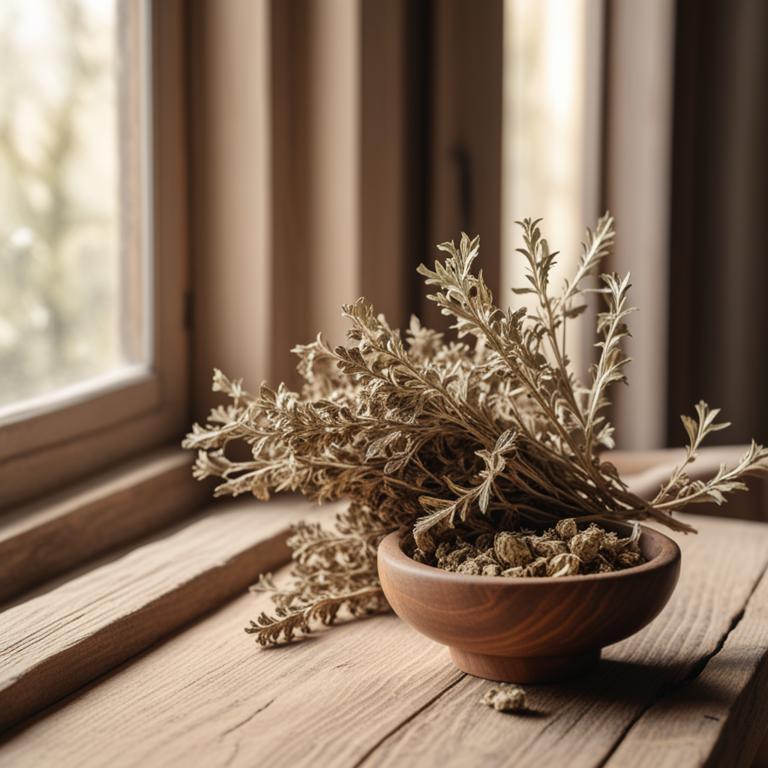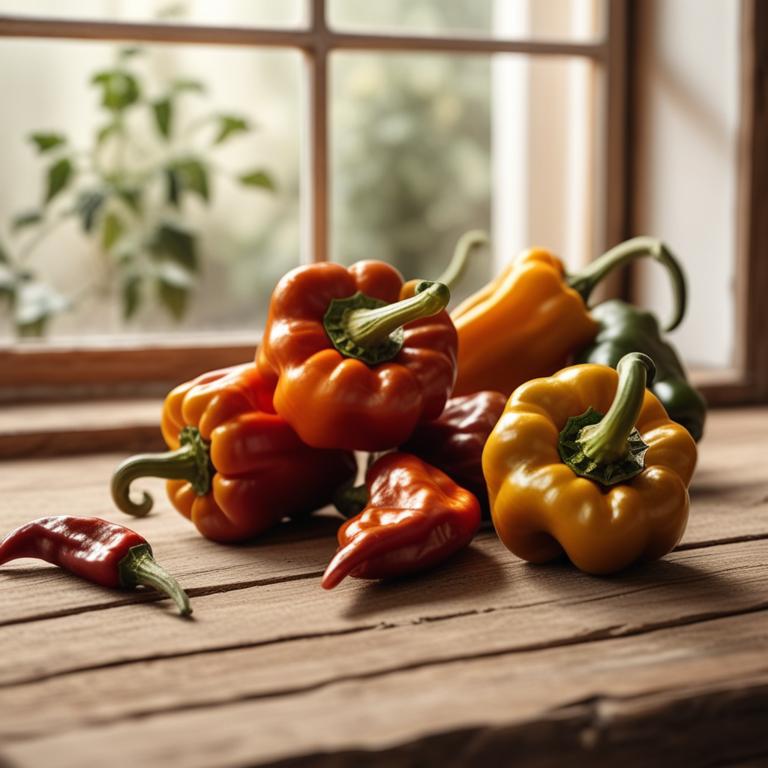Updated: Nov 30, 2024
10 Herbal Teas For Bursitis
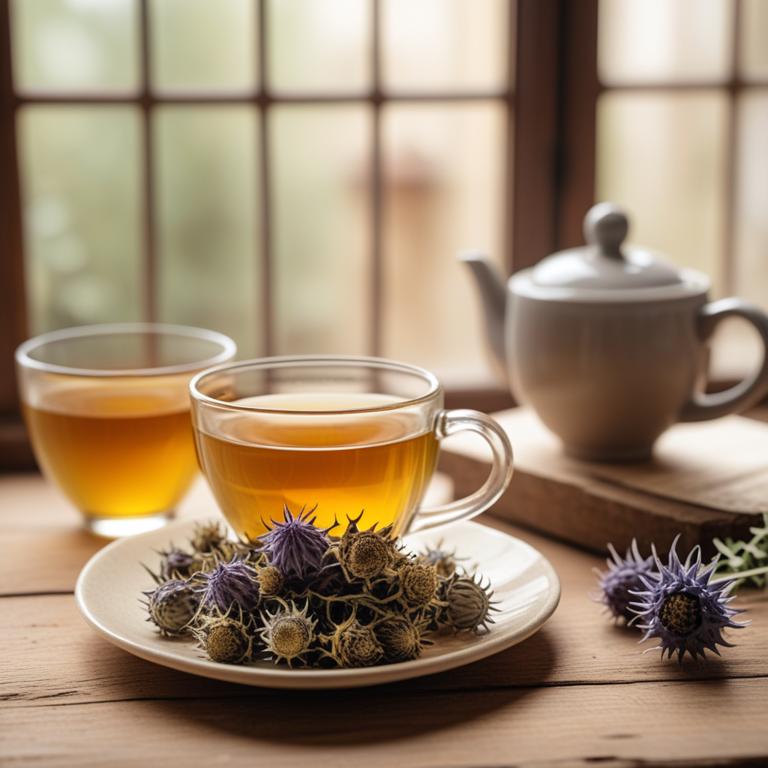
If you're living with bursitis, you know how painful it can be.
Bursitis is inflammation of the fluid-filled sacs that cushion joints, and it can make everyday activities a challenge. Herbal teas can be a great help in relieving bursitis symptoms. They work by reducing inflammation and pain, and promoting healing in the affected area. One herb that's often used to relieve bursitis is Yarrow, or Achillea millefolium. Its anti-inflammatory properties help to reduce swelling and pain in the joints. Yarrow tea also has a soothing effect on the muscles and tendons, which can become irritated and inflamed during a bursitis flare-up. Echinacea purpurea is another herb that's commonly used to treat bursitis.
It's known for its immune-boosting properties, which can help to fight off infections that can exacerbate bursitis. Echinacea tea can also help to reduce inflammation and promote healing in the affected area. Ginger, or Zingiber officinale, is a popular herb that's often used to relieve bursitis symptoms. Its anti-inflammatory compounds, such as gingerol and shogaol, help to reduce pain and swelling in the joints. Ginger tea can also help to reduce nausea and promote digestion, which can become disrupted during a bursitis flare-up. Drinking herbal teas can bring many benefits to your life when you're living with bursitis. For one, it can help you to manage your symptoms and reduce your reliance on pain medication. It can also help you to stay hydrated and promote healing in the affected area.
Additionally, herbal teas can be a soothing and calming way to relax and reduce stress, which can become overwhelming when you're dealing with chronic pain.
This article explains in detail what are the best herbal teas for bursitis and wh.
Also, you may be interested in...
Today Free Bonus!
The Ultimate Herb Drying Checklist
(For Long-Lasting Powerful Medicinal Effect)
How to easily dry herbs that don't mold and that keep their strong medicinal power for more than 1 year.
Table of Contents
1. Achillea millefolium
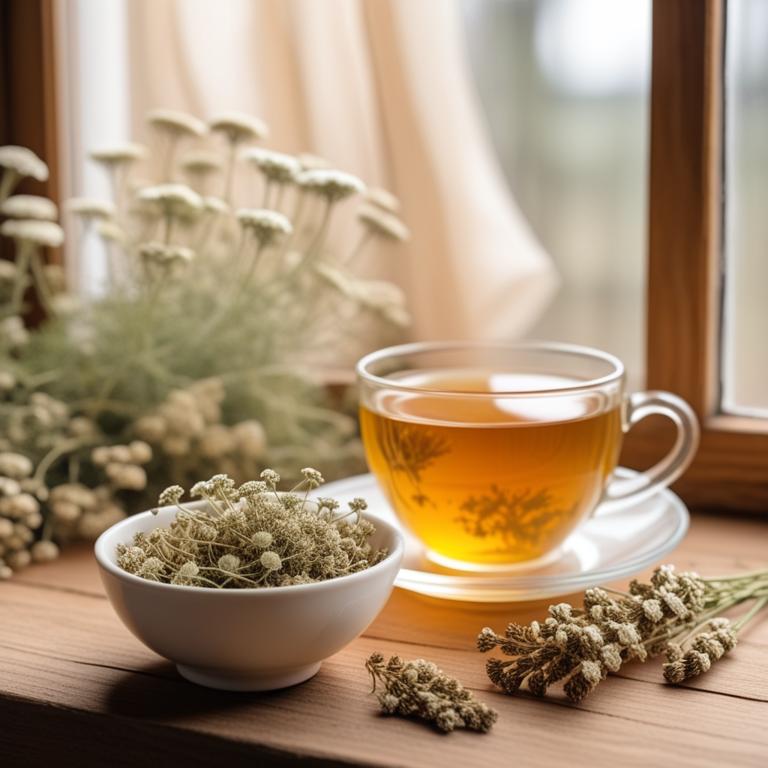
Achillea millefolium teas contains bioactive constituents like sesquiterpene lactones, flavonoids, and phenolic acids.
These compounds have anti-inflammatory and antioxidant properties that help reduce pain and swelling associated with bursitis. The sesquiterpene lactones, specifically, inhibit the production of pro-inflammatory enzymes, which contribute to the development of bursitis. The flavonoids and phenolic acids in Achillea millefolium teas also have antioxidant properties, which help protect the affected tissue from oxidative damage and promote healing.
By reducing inflammation and oxidative stress, Achillea millefolium teas can help alleviate bursitis symptoms and promote recovery.
- Gather 2 cups of fresh Achillea millefolium leaves and flowers. Clean them with water.
- Dry the leaves and flowers completely using a food dehydrator or by air-drying them.
- Measure 2 tablespoons of dried Achillea millefolium and place them in a tea infuser.
- Heat 1 cup of boiling water and pour it over the tea infuser. Let it steep for 5-7 minutes.
- Strain the tea and drink 1-2 cups a day to help with bursitis relief.
Yarrow Tea on Amazon
Wild Bliss Organic Yarrow Tea - Caffeine Free Herbal Tisane - Pharmacopoeia Potency - 20 Plant Based Tea Bags
Disclaimer: We earn a commission if you click this link and make a purchase at no additional cost to you.
2. Echinacea purpurea
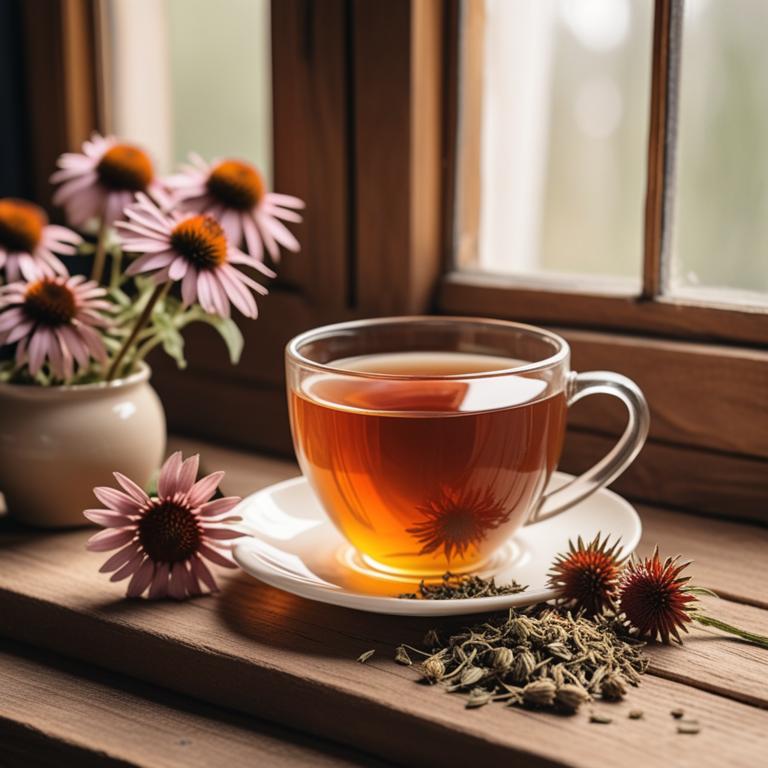
Echinacea purpurea teas contains a mix of bioactive constituents, including alkylamides, caffeic acid, and flavonoids.
These compounds have anti-inflammatory properties, which can help reduce swelling and pain associated with bursitis. The flavonoids in Echinacea purpurea, such as kaempferol and quercetin, have been shown to inhibit the production of pro-inflammatory enzymes, further reducing inflammation. Alkylamides in the tea may also help to reduce pain and inflammation by blocking the production of pain-causing chemicals.
By consuming Echinacea purpurea teas, individuals with bursitis may experience relief from symptoms due to its anti-inflammatory and pain-reducing properties.
- Gather 2 teaspoons of dried Echinacea purpurea root and 1 teaspoon of dried Echinacea purpurea flowers.
- Boil 1 cup of water in a pot.
- Add the dried Echinacea root and flowers to the boiling water.
- Reduce heat and simmer for 5-7 minutes, then remove from heat.
- Strain the tea into a cup and drink 2-3 times a day for bursitis relief.
Purple Coneflower Tea on Amazon
Purple Coneflower Herb Echenecia Tea - Immunity Support Tea - Echinacea Tea Coneflower Tea Echinacea Herb Purple Tea Echinacea Herb Dry Echinacea Dried Herb Echinacea Leaves Purple Echinacea Tea
Disclaimer: We earn a commission if you click this link and make a purchase at no additional cost to you.
3. Zingiber officinale

Zingiber officinale teas contains compounds like gingerols and shogaols, which have anti-inflammatory properties that help reduce swelling and pain associated with bursitis.
Ginger's bioactive constituents also have analgesic and antiseptic properties, making it effective in treating the condition. The tea's active compounds inhibit the production of pro-inflammatory enzymes and cytokines, which contribute to the inflammation and pain of bursitis. Zingiber officinale's antioxidant properties help protect the affected area from oxidative stress and promote healing.
Regular consumption of Zingiber officinale tea may help alleviate the symptoms of bursitis by reducing inflammation and promoting recovery.
- Gather 1 tablespoon of dried Zingiber officinale (Ginger) root.
- Boil 1 cup of water in a pot.
- Add the ginger root to the boiling water and reduce heat.
- Steep for 5-7 minutes and then strain the tea.
- Drink 1-2 cups of the ginger tea 2-3 times a day to help manage bursitis symptoms.
Ginger Tea on Amazon
FGO Organic Ginger Tea, Eco-Conscious Tea Bags, 100 Count, Packaging May Vary (Pack of 1)
Disclaimer: We earn a commission if you click this link and make a purchase at no additional cost to you.
4. Glycyrrhiza glabra

Glycyrrhiza glabra teas contains compounds like glycyrrhizin, which has anti-inflammatory properties.
Glycyrrhizin helps reduce swelling and pain by inhibiting the production of prostaglandins, hormone-like substances that cause inflammation. The flavonoids present in Glycyrrhiza glabra tea, such as liquiritin and isolarictin, have antioxidant properties that help protect against oxidative stress and damage to joint tissues. Glycyrrhizin also has a corticosteroid-like effect, which can help reduce swelling and pain in bursitis.
By reducing inflammation and promoting healing, Glycyrrhiza glabra tea can help alleviate symptoms of bursitis and promote recovery.
- Gather 2 cups of water and 1 tablespoon of dried Glycyrrhiza glabra root.
- Boil the water in a pot and let it cool for 5 minutes.
- Add 1 tablespoon of dried Glycyrrhiza glabra root to the pot and let it steep for 5-7 minutes.
- Strain the tea into a cup and discard the root.
- Drink the tea 2-3 times a day to help with bursitis symptoms.
Licorice Tea on Amazon
FullChea - Licorice Root Tea Bag, 40 Teabags, 2g/bag - Premium Licorice Root - Non-GMO - Naturally Caffeine-free Herbal Tea - Aid in Digestion & Promote Respiratory Health
Disclaimer: We earn a commission if you click this link and make a purchase at no additional cost to you.
5. Curcuma longa
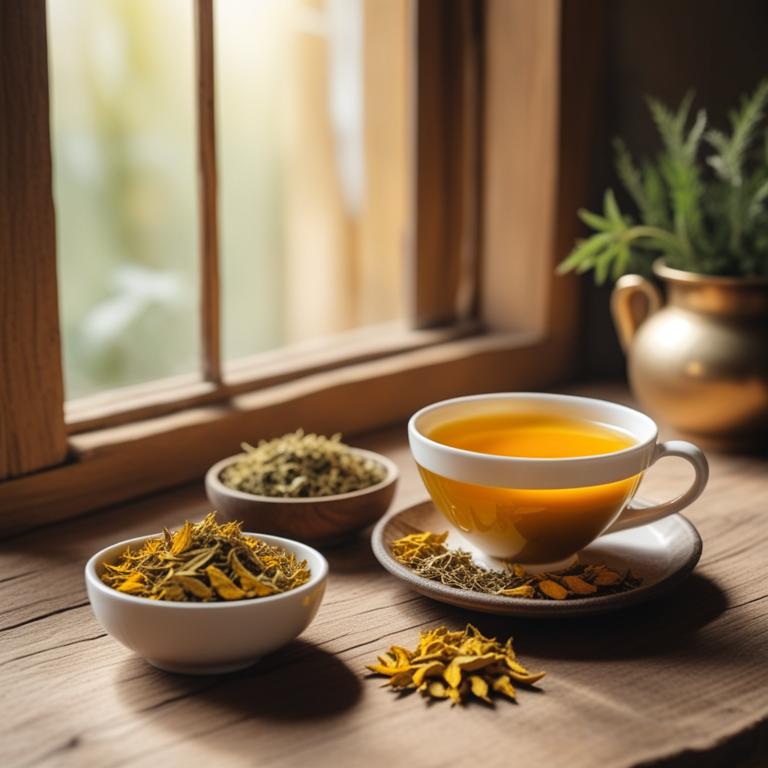
Curcuma longa teas contains a compound called curcumin, which is responsible for its anti-inflammatory properties.
Curcumin has been shown to inhibit the production of pro-inflammatory enzymes, such as COX-2 and LOX, which contribute to the pain and swelling associated with bursitis. Turmeric, the main active constituent of Curcuma longa teas, also contains other anti-inflammatory compounds like demethoxycurcumin and bisdemethoxycurcumin, which work together to reduce inflammation. The antioxidants in Curcuma longa teas, including curcumin and other polyphenols, help to neutralize free radicals that can damage tissues and exacerbate bursitis symptoms.
By reducing inflammation and oxidative stress, Curcuma longa teas may help alleviate the pain and discomfort associated with bursitis.
- Gather 1 tablespoon of dried turmeric root (Curcuma longa) and a cup of boiling water.
- Place the turmeric root in a tea infuser or a small strainer.
- Pour the boiling water over the turmeric root and let it steep for 5-7 minutes.
- Strain the tea into a cup and discard the turmeric root.
- Drink 1-2 cups of turmeric tea 2-3 times a day to help alleviate bursitis symptoms.
6. Cinchona officinalis
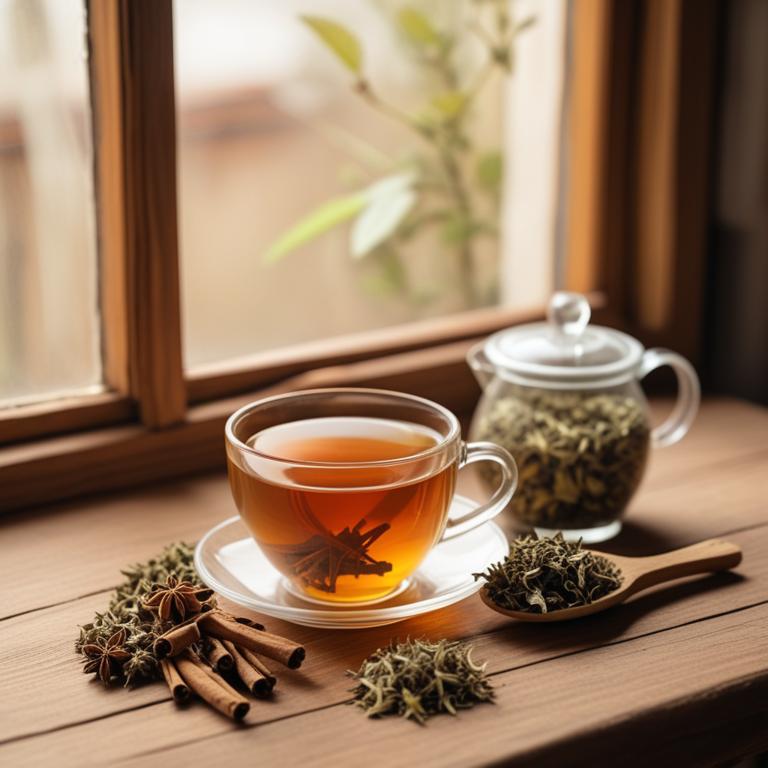
Cinchona officinalis teas contains the bioactive constituents quinine and alkaloids, which have anti-inflammatory properties.
These properties help reduce swelling and pain associated with bursitis, an inflammatory condition that affects the fluid-filled sacs that cushion joints and bones. Quinine, in particular, has been shown to inhibit the production of pro-inflammatory enzymes, which contribute to the development of bursitis. The alkaloids in Cinchona officinalis also possess antioxidant properties, which help protect the body from oxidative stress and promote healing.
By reducing inflammation and promoting healing, Cinchona officinalis teas may provide relief from the symptoms of bursitis, such as pain and limited mobility.
- Gather 1 cup of dried Cinchona officinalis bark and 1 cup of boiling water.
- Add 1 tablespoon of dried Cinchona officinalis bark to a tea infuser or a heat-resistant cup.
- Pour 1 cup of boiling water over the Cinchona officinalis bark.
- Let it steep for 5-7 minutes, then strain the tea into another cup.
- Drink the tea 2-3 times a day for bursitis relief, but consult a doctor before using it as a treatment.
7. Urtica dioica
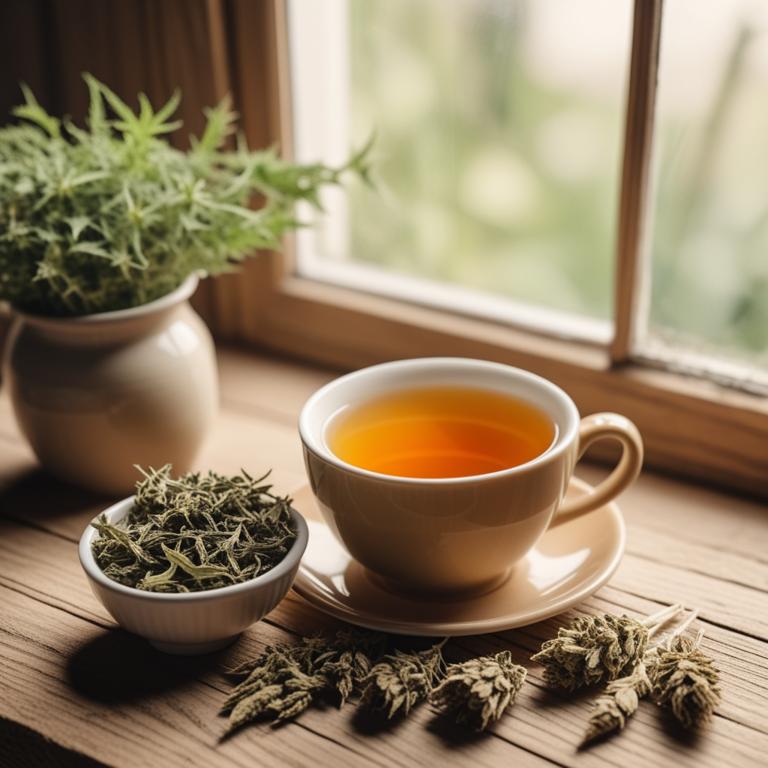
Urtica dioica teas contains bioactive constituents like quercetin and isorhapontigenin, which have anti-inflammatory properties that help reduce swelling and pain in bursitis.
These compounds work by inhibiting the production of pro-inflammatory enzymes and reducing the levels of inflammatory cytokines in the body. The diuretic and anti-inflammatory properties of quercetin also help to reduce fluid buildup in the affected area, which is common in bursitis. Isorhapontigenin, on the other hand, has been shown to inhibit the production of prostaglandins, which are hormone-like substances that promote inflammation.
By reducing inflammation and swelling, Urtica dioica teas can help alleviate the symptoms of bursitis and promote healing in the affected area.
- Gather 2 tablespoons of dried Urtica dioica leaves and flowers, 1 cup of boiling water, and a tea strainer or infuser.
- Measure 2 tablespoons of dried Urtica dioica leaves and flowers into a tea infuser or strainer.
- Pour 1 cup of boiling water over the dried Urtica dioica leaves and flowers in the infuser or strainer.
- Steep the mixture for 5-7 minutes, then strain the liquid into a cup using the tea infuser or strainer.
- Drink the Urtica dioica tea warm or at room temperature, 2-3 times a day, as needed for bursitis relief.
8. Arnica montana
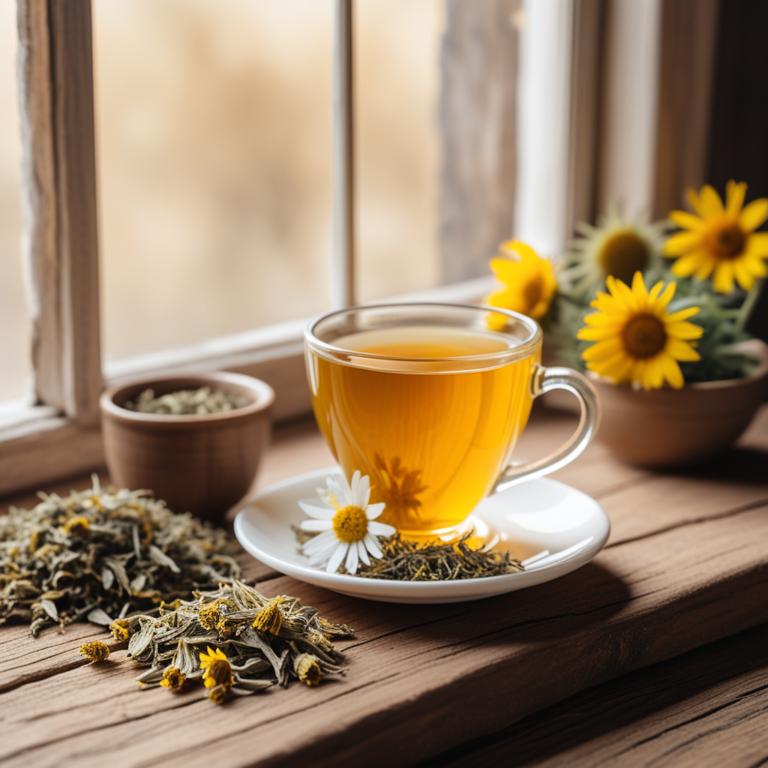
Arnica montana teas contains flavonoids, phenolic acids, and sesquiterpene lactones as its bioactive constituents.
These compounds have anti-inflammatory and antioxidant properties that help reduce swelling and pain associated with bursitis. The sesquiterpene lactones in Arnica montana, particularly arnadin and arnicol, have been shown to inhibit the production of pro-inflammatory enzymes, which contribute to the development of bursitis. The antioxidants in Arnica montana tea also help protect against oxidative stress, which can exacerbate inflammation in the affected area.
The combination of anti-inflammatory and antioxidant properties in Arnica montana teas makes it a potential natural remedy for relieving bursitis symptoms.
- Gather 1 cup of dried Arnica montana flowers and 2 cups of boiling water in a heat-proof cup.
- Steep the dried flowers in the boiling water for 5-7 minutes.
- Strain the liquid using a piece of cheesecloth or a fine-mesh sieve into a separate cup.
- Discard the solids and add 1 tablespoon of honey (optional) to the liquid tea.
- Drink 1/2 cup of the tea, 3 times a day, for bursitis relief.
9. Arctium lappa
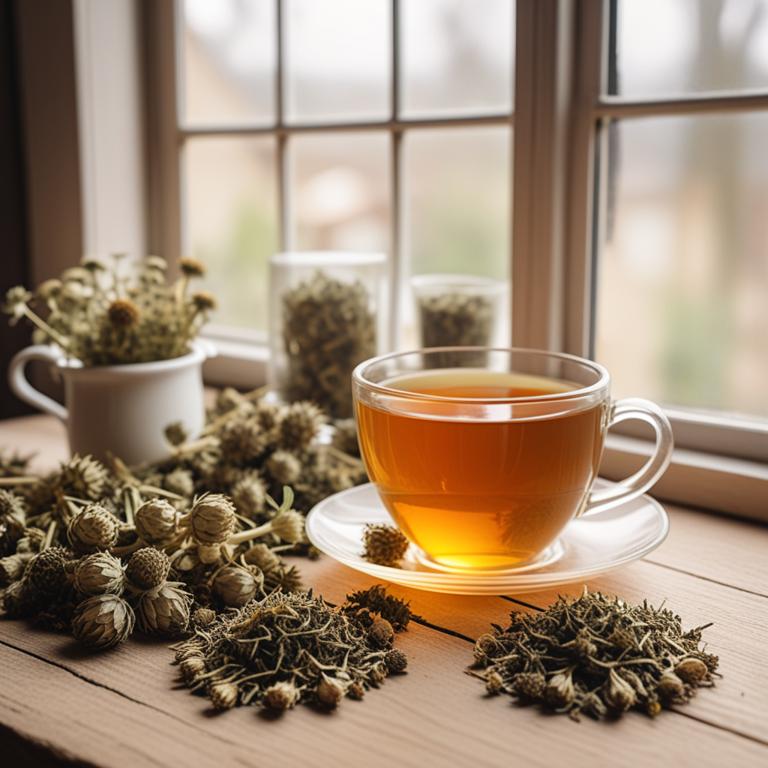
Arctium lappa teas contains inulin, a type of soluble fiber, and arctiin, a sesquiterpene lactone.
These compounds have anti-inflammatory properties, which can help reduce swelling and pain associated with bursitis. Inulin also has antioxidant properties that can help protect the affected joint from oxidative damage. Arctiin has been shown to inhibit the production of pro-inflammatory cytokines, which contribute to the inflammation and pain of bursitis.
By consuming Arctium lappa tea, some people have experienced relief from bursitis symptoms, possibly due to its ability to reduce inflammation and promote joint health.
- Gather 2 tablespoons of dried Arctium lappa root.
- Place the root in a cup and add 1 cup of boiling water.
- Let it steep for 5-7 minutes to allow the roots to release their properties.
- Strain the liquid using a tea strainer or cheesecloth to remove the roots.
- Drink the tea 2-3 times a day to help alleviate bursitis symptoms.
10. Silybum marianum

Silybum marianum teas contains silymarin, a mixture of flavonoids and polyphenolic compounds, specifically silibinin, silidianin, and silicristin.
These bioactive constituents have anti-inflammatory and antioxidant properties, which can help reduce swelling and pain associated with bursitis. The flavonoids in silymarin tea have been shown to inhibit the production of pro-inflammatory cytokines, which contribute to the development of bursitis. The antioxidant properties of silymarin can also help protect the affected area from oxidative stress and damage.
By reducing inflammation and protecting the affected area, silymarin tea may help alleviate symptoms of bursitis and promote healing.
- Gather 2 tablespoons of dried Silybum marianum flowers and leaves.
- Use a tea infuser or a heat-resistant cup to steep 1 cup of boiling water.
- Add the Silybum marianum mixture to the infuser or the cup of boiling water.
- Steep for 5-7 minutes, then strain the liquid using a tea strainer or cheesecloth.
- Drink 1/2 to 1 cup of the Silybum marianum tea 2-3 times a day for bursitis relief.
FAQ
Can drinking herbal tea prevent bursitis from forming?
Drinking herbal tea may help with bursitis prevention.
Some herbal teas, like ginger and turmeric tea, contain anti-inflammatory compounds that may reduce swelling and pain. These teas can also promote blood flow, which might aid in healing and reducing the risk of bursitis.
However, the effectiveness of herbal tea for bursitis prevention is not well understood.
Is it safe to consume herbal teas for bursitis every day?
Herbal teas can be a soothing way to ease bursitis pain.
However, drinking them every day may not be safe for everyone. Some herbal teas can interact with medications or worsen underlying conditions. It's essential to monitor your body's response and adjust your consumption accordingly.
Start with small amounts and observe how your body reacts.
How long does it take for herbal teas to show results in bursitis?
Herbal teas can help with bursitis, but it's hard to say exactly when you'll notice results.
It's different for everyone, but some people start feeling better within a week or two after drinking tea regularly.
It might take longer to see significant improvements in pain and swelling.
Related Articles
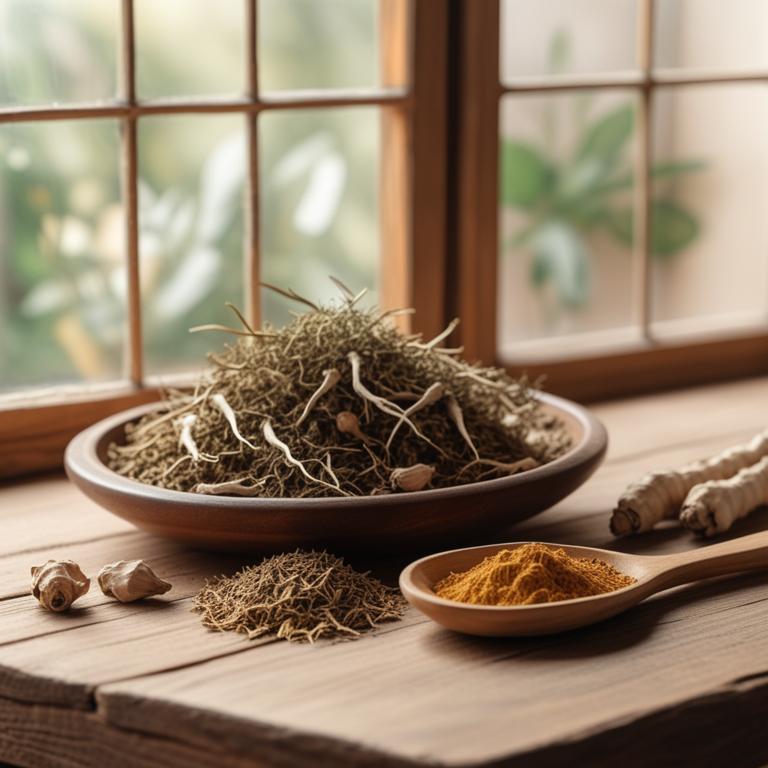
Knee Swelling: A Guide to Medicinal Herbs and Natural Preparations
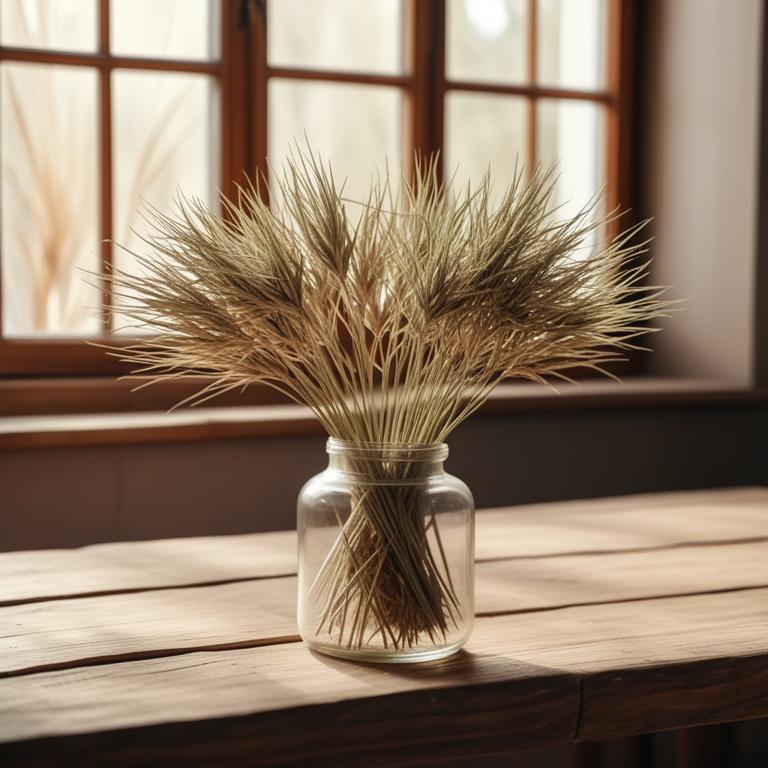
Foot Pain: Causes, Herbal Treatment Options, and Natural Preparations
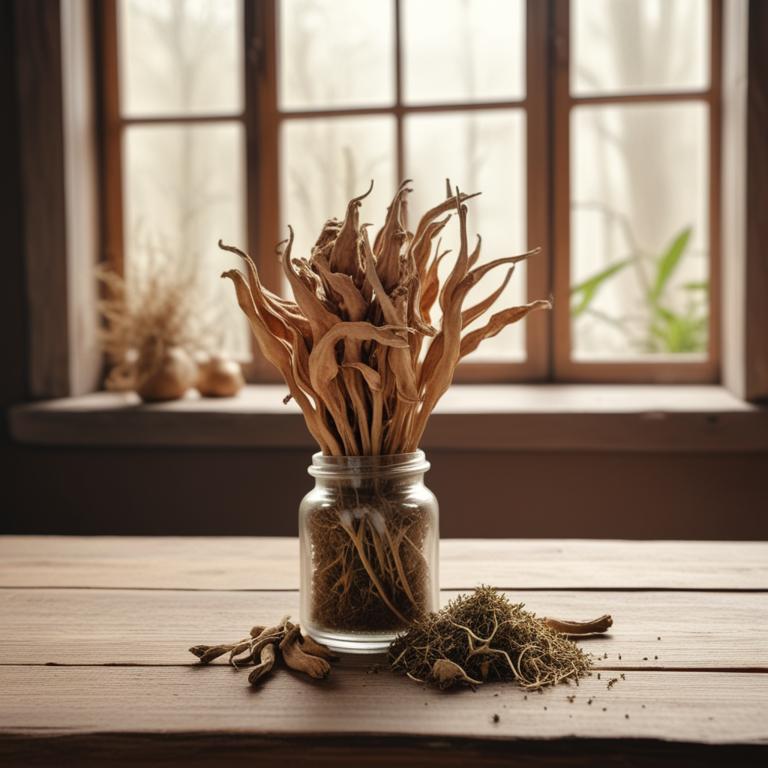
Tendinitis Relief: Exploring Medicinal Herbs and Their Preparations
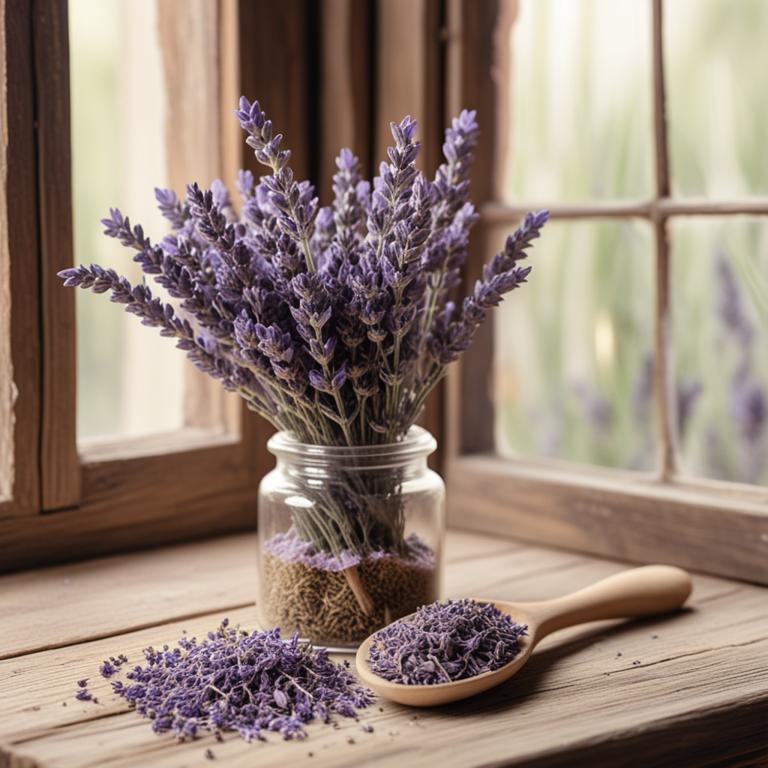
Jaw Clenching and Bruxism: Causes, Medicinal Herbs, and Herbal Preparations
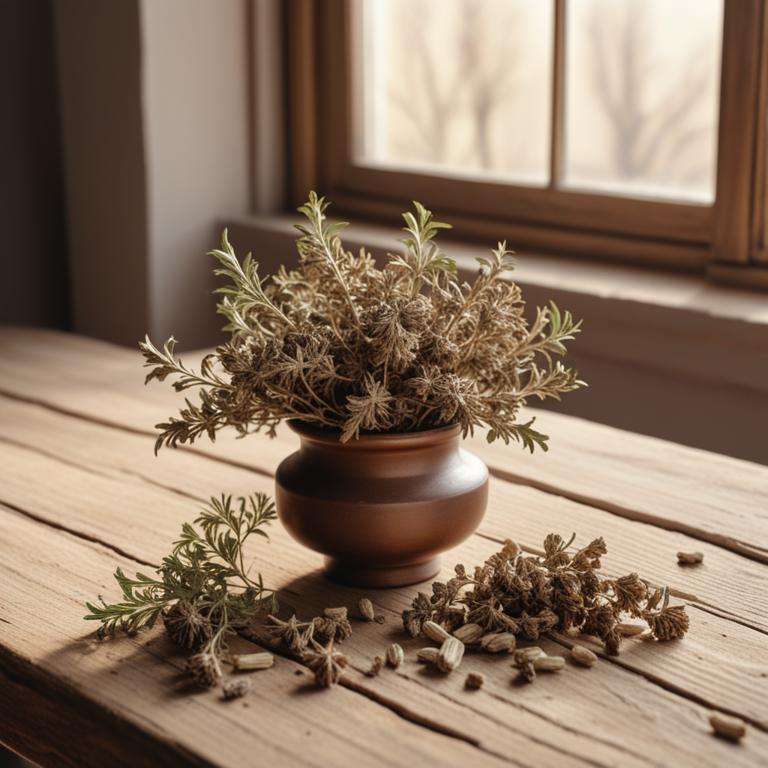
Difficulty Chewing: Understanding the Causes and Medicinal Herbs
